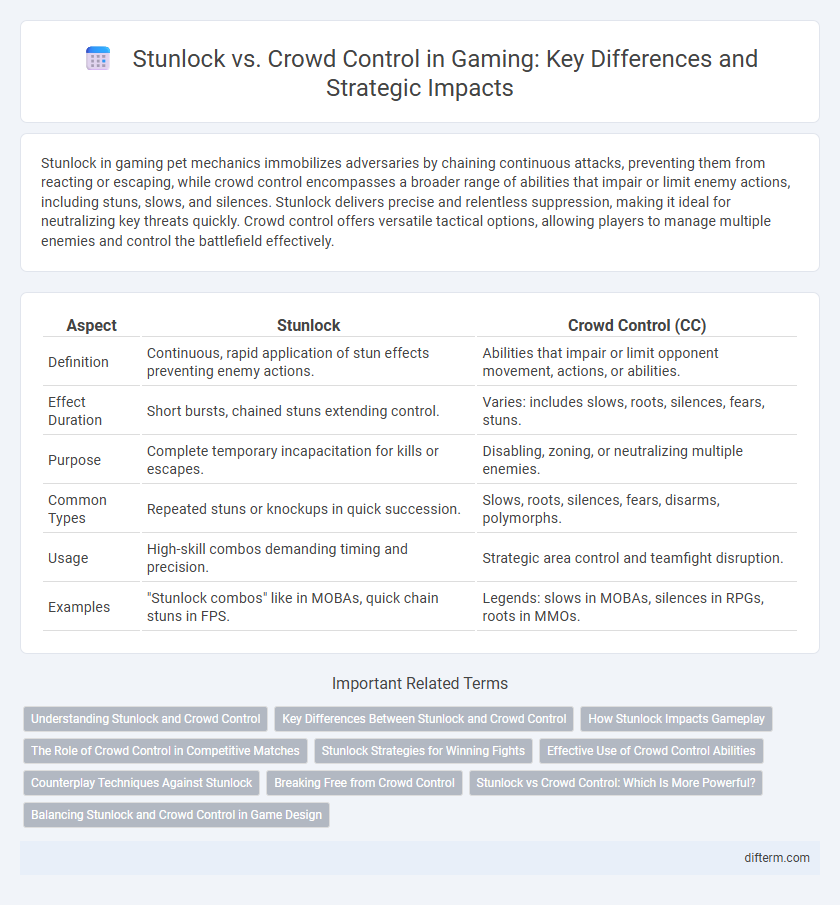Stunlock in gaming pet mechanics immobilizes adversaries by chaining continuous attacks, preventing them from reacting or escaping, while crowd control encompasses a broader range of abilities that impair or limit enemy actions, including stuns, slows, and silences. Stunlock delivers precise and relentless suppression, making it ideal for neutralizing key threats quickly. Crowd control offers versatile tactical options, allowing players to manage multiple enemies and control the battlefield effectively.
Table of Comparison
| Aspect | Stunlock | Crowd Control (CC) |
|---|---|---|
| Definition | Continuous, rapid application of stun effects preventing enemy actions. | Abilities that impair or limit opponent movement, actions, or abilities. |
| Effect Duration | Short bursts, chained stuns extending control. | Varies: includes slows, roots, silences, fears, stuns. |
| Purpose | Complete temporary incapacitation for kills or escapes. | Disabling, zoning, or neutralizing multiple enemies. |
| Common Types | Repeated stuns or knockups in quick succession. | Slows, roots, silences, fears, disarms, polymorphs. |
| Usage | High-skill combos demanding timing and precision. | Strategic area control and teamfight disruption. |
| Examples | "Stunlock combos" like in MOBAs, quick chain stuns in FPS. | Legends: slows in MOBAs, silences in RPGs, roots in MMOs. |
Understanding Stunlock and Crowd Control
Stunlock refers to the continuous application of abilities that keep an opponent immobilized or unable to act, preventing any form of retaliation or movement. Crowd Control (CC) encompasses a broader range of effects, including stuns, slows, silences, roots, and fears, designed to limit enemy actions temporarily during combat. Mastery of stunlock and diverse crowd control skills is essential for manipulating enemy positioning and controlling the flow of battles in multiplayer games.
Key Differences Between Stunlock and Crowd Control
Stunlock and crowd control are distinct mechanics in gaming, with stunlock preventing any action by rapidly chaining attacks that reset the target's animation, effectively locking them in place. Crowd control encompasses a broader range of effects, including roots, silences, fears, and slows that restrict movement or abilities without necessarily interrupting every action. Understanding these differences is crucial for optimizing player strategies, as stunlock guarantees absolute action prevention while crowd control offers varied levels of disruption.
How Stunlock Impacts Gameplay
Stunlock significantly impacts gameplay by preventing opponents from executing actions, effectively controlling the pace of combat and creating openings for follow-up attacks. This mechanic increases strategic depth, as players must time abilities precisely to maintain stunlock chains and disrupt enemy responses. Proper utilization of stunlock can decisively tilt fights in favor of the controlling player or team, emphasizing skill and timing over raw damage output.
The Role of Crowd Control in Competitive Matches
Crowd control (CC) plays a pivotal role in competitive gaming by enabling teams to temporarily disable or limit opponents' actions, creating opportunities for strategic plays and objective captures. Effective use of stunlock, a form of CC that chains multiple effects to keep enemies locked down, can decisively sway team fights by preventing key enemy champions from executing their abilities. Mastery of crowd control timing and target prioritization often determines the outcome of high-level matches in games such as League of Legends, Dota 2, and Overwatch.
Stunlock Strategies for Winning Fights
Stunlock strategies in gaming involve continuously applying crowd control effects to prevent opponents from acting, effectively locking them down during fights. Implementing precise timing with abilities like stuns, roots, and silences maximizes damage output while denying enemy responses. Mastery of chaining multiple crowd control effects creates opportunities for teammates to secure kills and control the battlefield momentum.
Effective Use of Crowd Control Abilities
Effective use of crowd control (CC) abilities in gaming hinges on timing and target priority to maximize team impact. Stunlock techniques, which repeatedly interrupt an enemy's actions, synergize with CC effects like stuns, roots, and silences to prevent opponents from responding or escaping. Mastering the balance between initiating stuns and applying sustained crowd control ensures continuous disruption, enhancing overall combat control and increasing the likelihood of victory.
Counterplay Techniques Against Stunlock
Counterplay techniques against stunlock in gaming primarily involve mastering crowd control immunities and timing defensive abilities to break or avoid the chain. Utilizing abilities that provide invulnerability frames, such as dodges or shields, helps players escape dangerous stunlock combos. Strategic spacing and awareness of enemy cooldowns enable effective disruption of consecutive crowd control effects, minimizing the risk of being locked down.
Breaking Free from Crowd Control
Breaking free from crowd control in gaming often requires specific cooldowns, items, or abilities designed to disable or reduce the effects of stuns, roots, and slows. Stunlock, a tactic involving continuous crowd control to prevent any player action, is countered effectively through cleanse spells, anti-CC gear, and well-timed defensive skills. Mastering escape mechanics like invulnerability frames or displacement abilities significantly increases survivability against prolonged crowd control combos.
Stunlock vs Crowd Control: Which Is More Powerful?
Stunlock and crowd control both play critical roles in gaming strategies, with stunlock preventing enemy actions by repeatedly interrupting their movements while crowd control affects groups through effects like slows, stuns, or silences. Stunlock offers direct, immediate control over individual targets, making it highly effective in duels or key target neutralization. Crowd control excels in controlling multiple enemies simultaneously, providing strategic advantages in team fights and area control, ultimately determining its power based on game context and team synergy.
Balancing Stunlock and Crowd Control in Game Design
Balancing stunlock and crowd control in game design requires careful tuning of effect durations to prevent player frustration while maintaining strategic depth. Effective design limits stunlock effects to short bursts, ensuring players can react and counterplay without feeling powerless. Integrating cooldown management and diminishing returns on crowd control abilities promotes fair gameplay and preserves dynamic combat experiences.
Stunlock vs Crowd Control Infographic

 difterm.com
difterm.com